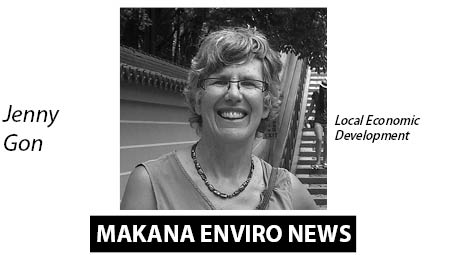Compiled by Jenny Gon
Let’s go thicketeering!
Members of the Ght WESSA branch recently went ‘thicketeering’ with Mike Powell, from the Rhodes Restoration Research Group. Mike is passionate about thicket, a highly threatened vegetation type. He is currently developing restoration protocols for thicket woody species, to assist in the restoration of degraded thicket areas in the Albany area.
First stop was the project’s Waainek nursery area where a number of trials are underway to identify 20–30 suitable restoration species which would be useful ‘in the wild’. Plants being trialled include local favourites such as wild plum (Harpephyllum caffrum), Cape ash (Ekebergia capensis), and sneezewood (Ptaeroxylon obliquum). Mike explained that as most thicket plants are not available from regular nurseries, they harvest the seeds from target thicket plants. They treat the seeds in various ways, such as opening up the outside layer (scarification) of the seed, to make it germinate more easily. It’s a challenge to get some species to germinate at all! Mike went on to show how they put the successfully germinated seedlings into long bags – this allows the plants to grow long roots, which increases their chances of survival when planted in the wild. They are also testing the seedlings to see how they will cope with drought, by giving them different amounts of water. Mike is also looking at different soil combinations (sand/potting soil/clay) to determine optimal water infiltration rates combined with the maximum water holding capacity of the soil combinations.
From Waainek, the group then travelled to Bathurst to visit the field site – an old chicory field. The old fields are dominated by 15 thicket species that have returned naturally via succession in the last 36 years, but a number of key guilds are completely missing (e.g. vines, creepers and bulbs). The absence of large mammals is possibly inhibiting the dispersal of many of the thicket plants, and part of the project’s aim is to look at how to get many of the other species back. The study site includes a fenced-off area to exclude the impacts of bushbuck, duiker, porcupine, baboons, monkeys and even vlei rats! Numerous plots of various plant combinations are being studied both inside and outside the fenced area. Mike also is trying a number of innovative rainwater harvesting strategies, as well as tree shelters to encourage plant survival.
The research is being funded by the National Research Foundation (NRF), the Department of Environmental Affairs (DEA) and the Chief Directorate Natural Resource Management – (NRM). We wish Mike every success with his project and all his efforts to conserve our precious thicket habitat. More info: contact Mike at m.powell@ru.ac.za
Putting SA orchids on the map
A group of nature lovers gathered in Bathurst last Saturday, at the invitation of the Friends of the Waters Meeting Reserve, to hear Prof. Craig Peter, an orchid enthusiast from the Rhodes University Botany Department, talking about SA orchids and their amazing variety, as well as the threat to these charismatic flowers. We have almost 500 orchid species in SA; and the Albany area has a rich mixture of tropical and fynbos species. It turns out that in recent years the collection of traditional herbarium specimens has been declining and our understanding of where orchids are found is becoming outdated. Craig introduced OrchidMAP to the audience and showed how easy it is for us all to become citizen scientists. The OrchidMAP project aims to collect photos rather than dried herbarium specimens to better understand the distribution and flowering times of orchids in SA. All one needs is a camera! When loading your pics on to OrchidMAP (OrchidMAP.adu.org.za), all your need to log on and submit photos with details of place and date (no id is required). A panel of experts will inspect each record. In its three years of existence, OrchidMAP has already collected 5000 digital orchid records — far exceeding the rate of collection of herbarium specimens.
The talk was followed by a field visit to the Waters Meeting Reserve where a number of epiphytic orchids and a single terrestrial orchid were identified. For more info on OrchidMAP, contact Craig Peter at OrchidMAP@ru.ac.za.
For more info on the recently formed Friends of Waters Meeting Reserve group, contact Ryana at friendsofwatersmeeting@gmail.com.
Find us Online: www.grocotts.co.za/category/outside/enviro-news
Contacts for Makana Enviro-News:
Nikki Köhly: n.kohly@ru.ac.za, 046 603 7205 | Tim Bull: timothybull05@aol.com, 076 289 5122 | Jenny Gon: j-gon@intekom.co.za, 046 622 5822 | Nick James: nickjames@intekom.co.za, 082 575 9781 | Philip Machanick: p.machanick@ru.ac.za, 046 603 8635.


